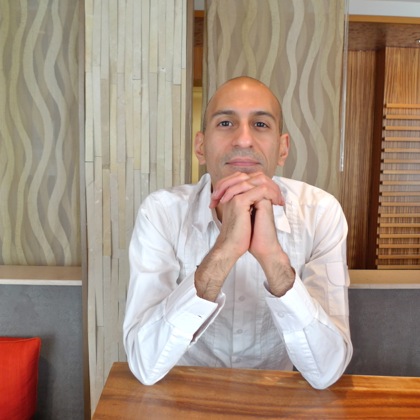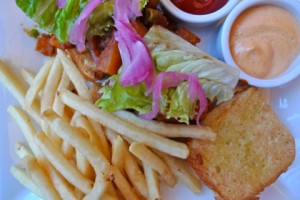From Bombay to Tribeca
 Jehangir Mehta moved to New York in 1993 to attend the Culinary Institute of America (CIA) in Hyde Park, N.Y. As a 21 year-old from Bombay who had never been to the U.S. before, he quickly suspected he might have made a mistake. Hyde Park was not the New York City he had heard about and seen on TV. But he managed to launch a career as a successful chef, restaurateur, and participant on “Iron Chef” and “The Next Iron Chef.” Last year, Mehta opened his second restaurant, Mehtaphor, which brought him to Tribeca. We sat down recently to discuss his thoughts about New York, Bombay, and his introduction to the American all-you-can-eat buffet.
Jehangir Mehta moved to New York in 1993 to attend the Culinary Institute of America (CIA) in Hyde Park, N.Y. As a 21 year-old from Bombay who had never been to the U.S. before, he quickly suspected he might have made a mistake. Hyde Park was not the New York City he had heard about and seen on TV. But he managed to launch a career as a successful chef, restaurateur, and participant on “Iron Chef” and “The Next Iron Chef.” Last year, Mehta opened his second restaurant, Mehtaphor, which brought him to Tribeca. We sat down recently to discuss his thoughts about New York, Bombay, and his introduction to the American all-you-can-eat buffet.
So what happened in Hyde Park? Where is Hyde Park anyway?
It’s near Poughkeepsie, north of New York City and it’s a beautiful place. But it wasn’t at all what I was expecting. I grew up in Bombay and I thought I was trading one city for another. Around the campus, there were no streetlights and I remember wondering how there could be places in the U.S. without streetlights—even the smallest villages in Bombay have streetlights.
Why did you pick CIA?
I knew I wanted to be a chef, and I looked at schools in England, France, Italy, and the U.S. I wanted a school geared mostly to cooking (as different from restaurant management, front of the house management, etc.) and CIA was the best for that.
Did you think you had made a mistake?
Yes, for the first six months. The winter was awful and up until that point, the coldest place I had ever been was the inside of a walk-in refrigerator. Plus, many of the other students smoked and did drugs. One thing I was really looking forward to getting away from in India was all the tobacco chewing and spitting. And wouldn’t you know it—I get to CIA and my assigned roommate chewed tobacco.
So how did it turn around for you?
After six months, students go off for training at restaurants but most foreign students stay on campus (it’s difficult to get work permits for short training periods). That was when I met a whole new group of people, including three students who became my friends for life. And the weather got better. After 20 years I still don’t like cold weather.
Were these new friends also foreigners?
No, they were New Yorkers. But they took me under their wing and made it their business to introduce me to “American” experiences. They took me to McDonald’s, took me bowling and showed me how to take smoking breaks on the highway (even though I don’t smoke). They made me go to an all-you-can-eat buffet and take way more food than I could ever eat—because that was the typical American way to do it.
After school you moved to New York. Was it everything you expected?
Absolutely. I don’t think I could live in any other city. I need energy around me all the time to keep me motivated and New York definitely has that.
How is New York different from Bombay?
It’s actually quite similar now. Bombay has all the restaurants, hotels and luxury shops that New York has, but there’s a lot more choice here since the wealth is spread over more people. In Bombay there are pockets of wealth, so that means Bombay might only have one Broadway show to New York’s twenty.
You have children. Is raising them here different from how you were raised?
Society is changing in both places. Everyone has a cellphone, iPod, etc. now and it’s extremely difficult to teach children the concept of value and how to appreciate things. But I think that’s a problem in both countries.
But both cities have people who are visibly living in poverty, so doesn’t that make it easier to teach kids to appreciate the things they have?
Poverty in the New York is nothing like it is in India. People in the U.S. are taken care of in a way the poor in India are not. There are so many organizations that give out free food or clothes, or teach you how to read or speak English—for free. There isn’t that kind of support in India.
What do you think about Tribeca? Your restaurant has been here for just over a year.
I never used to come to Tribeca and I still think it’s a destination, but it’s a dynamic neighborhood. And as the World Trade Center site is finished, it will become even more popular. There’s already a boom going on—new hotels, restaurants and shops—in anticipation of the upcoming influx. I expect real estate to be a lot more expensive in five years.
Where do you like to eat in Tribeca when you go out?
I actually don’t eat out that much. I throw lots of dinner parties and love to cook at home. I spend so much time in my restaurants that I usually don’t go to restaurants in my off hours.
What was your best NYC moment?
The blackout in 2003. It was such a serene and peaceful day—once it became clear it wasn’t another terrorist attack—and people helped one another out. It was so touching. Even criminals seemed to take the night off. In my building, people made an impromptu buffet in the lobby for neighbors who didn’t have food at home. The super gave away bottled water and people brought out nightstands with candles to each floor of the stairwell.
Is there anything you miss about India?
My family and friends, of course.
And do you consider yourself more American than Indian now? When did you first feel like that?
Yes, and I think it happened when I got married. My wife is Indian, but she became an American citizen before I met her. She made me feel more settled, and that’s when I knew I wouldn’t be moving back to India.
 About the author: Anojja Shah (left) is a Tribeca mom who spends her days running after a feisty 3-year-old. In past lives she worked as a journalist and on Wall Street in equity research. This Q&A is the seventh in her series of interviews with immigrants who live and/or work in Tribeca.
About the author: Anojja Shah (left) is a Tribeca mom who spends her days running after a feisty 3-year-old. In past lives she worked as a journalist and on Wall Street in equity research. This Q&A is the seventh in her series of interviews with immigrants who live and/or work in Tribeca.
Previous “I → NY” interviews:
••• From Paris to Tribeca: Sylvie Michel Bilger
••• From Arad to Tribeca: Lior Schapiro
••• From Fujian to Tribeca: Kevin Red
••• From Tokyo to Tribeca: Masako Chiba
••• From East Java to Tribeca: Rinta Juwana
••• From Montreal to Tribeca: Sarah Mlynowski















I love this feature. Years ago, CBC radio (Canada’s NPR) had a segment entitled “How I Got Here” which consisted of first person accounts of the immigrant experience. The stories were fascinating, often because, once in Canada people often lived in many different places before settling. Someone from a former French Colony would start in Quebec; someone with a willingness to work in difficult but lucrative conditions would begin in remote (often Northern) mining communities. The courage and drive it took to make the sacrifices necessary to reach for a better life was evident. And inspiring.